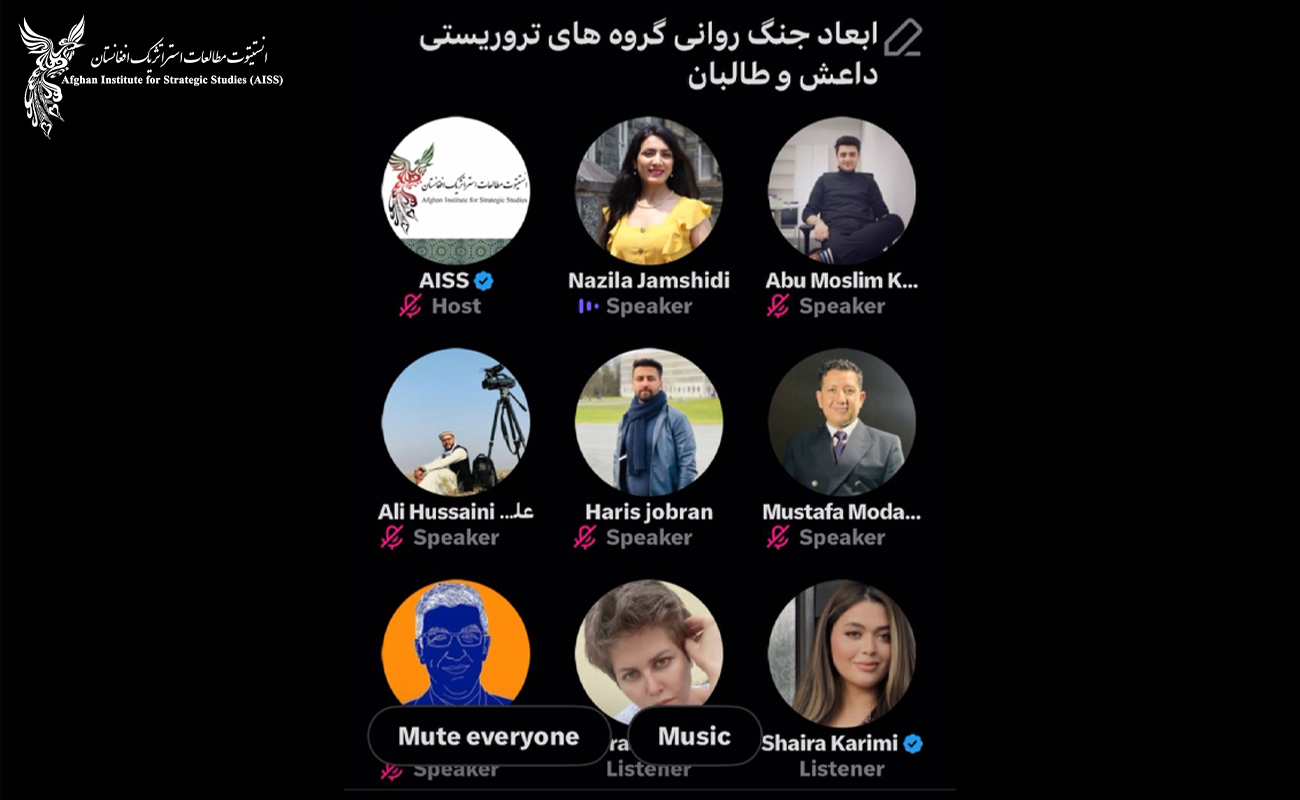Virtual Roundtable: Dimensions of psychological warfare tactics of the Taliban and ISIS terrorist groups
The Afghan Institute for Strategic Studies collaborated with Leipzig University in Germany to host a virtual roundtable discussion on March 7, 2024. The topic of discussion was the Dimensions of Psychological Warfare by Terrorist Groups Taliban and ISIS. The Institute launched this program through X-Space and continued it on Zoom Webinar.
Nazila Jamshidi, a diversity, equality, and inclusivity consultant, moderated the virtual roundtable. The program's guests included Mustafa Modaser, an international relations expert; Ali Seyed Hossaini, a BBC Persian correspondent; Kefayat Hamidi, a professor at Leipzig University, Germany; Haris Jabran, a security affairs expert; and Abu Moslim Khorasani, the author of this research, also affiliated with Leipzig University, Germany.
Abu Moslim Khorasani briefly described his research, published in the tenth issue of the Institute for Strategic Studies Afghanistan, stating, "Taliban and ISIS, considering themselves heirs of jihad, have entered a new war." He further discussed how terrorist groups ISIS and Taliban compete to recruit more forces by utilizing online spaces, also touching upon their strategies in delegitimizing each other's jihadist legitimacy through target audience language and methods.
Ali Seyed Hossaini, BBC Persian correspondent, discussed ISIS Khorasan and ISIS Central branch. He believes that over the past decade, this group has employed the most effective messaging strategy. He stated, "ISIS's messaging strategy aims to instill more fear and terror."
Hossaini continued, "A decade of deadly presence has proven that this international group sees communication of its activities and propaganda as one of its main power procurement strategies." He emphasized ISIS's use of various media formats and languages, including Arabic, English, French, Persian, Pashto, Spanish, Russian, Urdu, Uighur, and Kurdish, disseminated through audio, text, images, and videos.
Regarding ISIS propaganda content, Hossaini said, "Simultaneously, ISIS spreads its propaganda content through its magazines and media branches, including Al-Naba Newspaper, News of the Caliphate, Publications of Media Offices, Farouq Institute, Al-Hayat Center, Ansar Institute, Al-Azaim, Voice of Khorasan, Dabiq, Voice of India, and Yalghar."
Furthermore, Hossaini discussed ISIS's media operations and the effectiveness of its strategy in instilling fear. He stated, "While these magazines have functional similarities, they also have their features. Overall, ISIS's media operation is extensive, creative, and up-to-date, helping them broaden their media coverage to achieve their desired 'management of brutality.'"
Haris Jobran analyzed the different strategies adopted by the Taliban and ISIS in their ongoing conflict. He pointed out that the Taliban employs psychological warfare tactics to bolster their narrative, gain trust, and, most importantly, increase recruitment in various regions of Afghanistan prior to their eventual surrender. Through operationalizing its tactics such as indoctrination, launching deception operations, propaganda dissemination, and recruitment promises (paradise pledge), along with the fusion of traditional and modern methods, the group also utilized new platforms.
Jobran believed that ISIS's concern extended beyond these actions, aiming to use modern technology to advance its fear-mongering agenda. He said, "ISIS, utilizing modern technology, pursues more strategic objectives beyond messaging. One of their strategies is spreading fear and terror among their target audience. Although they aim to outpace rival groups (Al-Qaeda, Taliban) in psychological operations, their messaging method is the shortest route to the ultimate goal of 'becoming ISIS' and adhering to the ISIS manifesto."
Both ISIS and Taliban increasingly utilize social media for advertisement, recruitment, disseminating their ideologies, and advancing their goals.
Jobran added that ISIS employs high-quality cinematic techniques in its advertising content and utilizes various platforms such as Telegram, Twitter, Facebook, and YouTube. The group's recruitment involves a complex and layered approach, all conducted virtually through new platforms. Besides instilling fear and terror, ISIS aims to challenge the Taliban narrative as negotiators (apostates) and introduce their new approach to global issues.
According to Jobran, the Taliban, after recruiting new individuals, brings them into its fold through indoctrination, deception, and enticement operations. The group uses psychological operations to gain legitimacy, control public opinion, exaggerate service provision, and gain international recognition.
Both groups capitalize on trending topics on social media to their advantage.
Mustafa Modaser described the Taliban's simple narratives for recruitment, primarily through the group's songs using the Pashto language in public places and most mosques. He believed that ISIS currently employs the old methods of the Taliban in its current advertising.
Modaser also stated, "Sometimes, media and even previous Afghan government authorities use the term 'unsuccessful assassination,' which is inaccurate and precise. Terrorist groups achieve their main goal, which is fear, terror, and violence. Now, whether the assassination is successful or not."
He continued, "ISIS's advertising warfare method is very ruthless, terrifying, yet sensational and different at the same time. ISIS knows exactly where and how to conduct its advertising. ISIS's advertising section launches its propaganda with great rhetoric and skill. It sometimes presents Hollywood-like images of its massacres and brutality that other terrorist groups lack the capability and skill."
According to Modaser, ISIS has made the most use of technology and social networks among terrorist groups, and social media and the internet have made ISIS a global threat.
To download the PDF version of this newsletter in Persian, click on this link.

